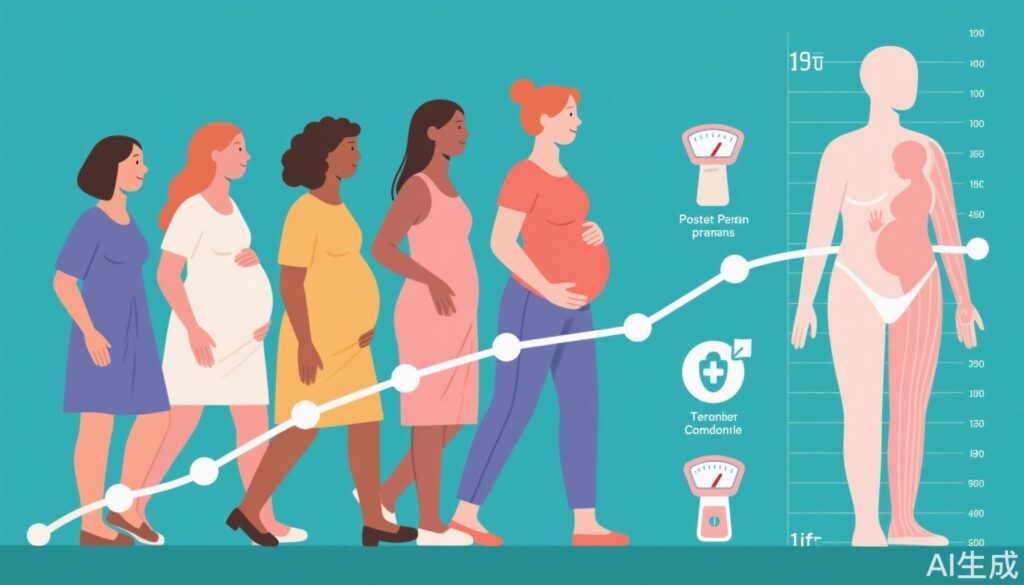Highlights
- Excessive gestational weight gain (GWG) is associated with increased adiposity, larger waist circumference, and significant long-term postpartum weight retention at 17 years post-delivery in Black and Dominican women.
- Only 32% of women met Institute of Medicine (IOM) GWG recommendations, with 60% of the cohort exceeding guidelines.
- No significant association was observed between GWG and long-term postpartum blood pressure.
- Findings underscore the clinical importance of GWG management in reducing long-term metabolic disparities, particularly among minority and low-income populations.
Study Background and Disease Burden
Gestational weight gain (GWG) is a modifiable determinant of maternal and infant health, impacting the risk of adverse pregnancy outcomes, postpartum weight retention, and long-term cardiometabolic disease. Although the Institute of Medicine (IOM) updated GWG guidelines in 2009 to align with body mass index (BMI) categories and reduce risks such as preterm birth and excessive postpartum weight, recent US data show that most women do not achieve guideline-concordant GWG. Only 32% of women meet these recommendations; 48% exceed and 20% fall short. The burden of excessive GWG—and its sequelae—is disproportionately borne by minority and low-income women, with obesity rates of 74% among non-Hispanic Black and 65% among Hispanic women of reproductive age. Previous studies have linked excessive GWG to adverse metabolic outcomes up to 16 years post-delivery, but few have examined longer-term adiposity, particularly in diverse, high-risk urban populations.
Study Design
This prospective cohort study leveraged data from the Columbia Center for Children’s Environmental Health birth cohort, initially designed to study prenatal exposures but expanded for maternal follow-up. Pregnant women (aged 18-35 years) of African American or Dominican descent, residing in New York City, were enrolled between 1998 and 2006, provided they had no diabetes, hypertension, HIV, substance use, or smoking history. Participants underwent repeated follow-up every 2 years postpartum until age 7, then at years 7, 9, 11, 14, and 17 post-delivery. The final analytic sample comprised 210 women who completed the 17-year follow-up and met inclusion criteria.
Primary exposures included total GWG (calculated as last prenatal visit weight minus self-reported pre-pregnancy weight) and categorized per 2009 IOM guidelines (inadequate, adequate, excessive). Outcomes at 17 years postpartum were adiposity measures (body fat percentage, fat mass, lean mass, waist circumference), long-term postpartum weight retention (LPPWR), and blood pressure (systolic, diastolic, and hypertension prevalence). Covariates included gestational age, age, breastfeeding, race/ethnicity, education, parity, marital status, public assistance, and food security. Analyses employed multivariable linear and logistic regression, with sensitivity analysis for attrition bias via inverse probability weighting.
Key Findings
Out of the 210 women, 60% exceeded IOM GWG recommendations. Excessive GWG was most prevalent among women with normal pre-pregnancy BMI (50%), followed by overweight (24%), obese (20%), and underweight (5%) groups. At 17 years postpartum, the mean BMI was 31.2 ± 6.7 kg/m², with 37% classified as obese and over 20% diagnosed with hypertension.
Compared to women with adequate GWG, those with inadequate GWG had nearly 3% lower body fat percentage at 17 years postpartum, while those with excessive GWG had higher body fat percentage, greater fat mass, more lean mass, and larger waist circumference—indicative of central adiposity. The mean LPPWR for the excessive GWG group was over 6 kg, suggesting persistent weight retention nearly two decades after pregnancy. However, there was no significant association between GWG and long-term blood pressure or hypertension. These results persisted after adjustment for potential confounders and were robust to sensitivity analyses for sample attrition.
The association between GWG (as a standardized z-score) and most long-term adiposity measures (body fat percentage, fat mass, waist circumference, LPPWR) was positive and statistically significant, while the relationship with lean mass was negative. No association was observed between GWG and systolic or diastolic blood pressure.
Expert Commentary
This study provides compelling evidence of the enduring metabolic consequences of excessive GWG, particularly in Black and Dominican women—a population at heightened risk for obesity and metabolic disease. The lack of association between GWG and blood pressure at 17 years is notable and may reflect the complex interplay of genetic, behavioral, and environmental factors influencing hypertension over the lifespan. The findings reinforce the critical importance of guideline-concordant GWG not just for immediate pregnancy outcomes but for long-term maternal health. Strengths include the long follow-up duration, focus on an underrepresented population, and robust statistical controls. However, limitations include potential residual confounding, self-reported pre-pregnancy weights, and sample attrition despite sensitivity analyses.
Conclusion
Excessive GWG has lasting effects on maternal adiposity and weight retention well into midlife for Black and Dominican women. These results underscore the need for targeted clinical and public health interventions to support appropriate GWG, particularly in minority and low-income populations, to mitigate long-term disparities in obesity and metabolic disease. Future research should address the optimal strategies for achieving guideline-concordant GWG, including tailored nutrition, behavioral counseling, and structural interventions.
References
1. Abrego MR, Rundle AG, Foster SF, et al. Gestational weight gain, cardiometabolic health, and long-term weight retention at 17 years post delivery. Obesity (Silver Spring). 2025;33(6):1145-1153. doi:10.1002/oby.24276
2. Institute of Medicine (US) and National Research Council (US) Committee to Reexamine IOM Pregnancy Weight Guidelines. Weight Gain During Pregnancy: Reexamining the Guidelines. National Academies Press (US); 2009.
3. Deputy NP, Dub B, Sharma AJ. Prevalence and trends in prepregnancy normal weight—48 states, New York City, and District of Columbia, 2011–2015. MMWR Morb Mortal Wkly Rep. 2018;66(51-52):1402-1407.
4. Gunderson EP, Abrams B, Selvin S. The relative importance of gestational gain and maternal characteristics associated with obesity in the development of obesity in young women. Int J Obes Relat Metab Disord. 2000;24(12):1660-1668.



